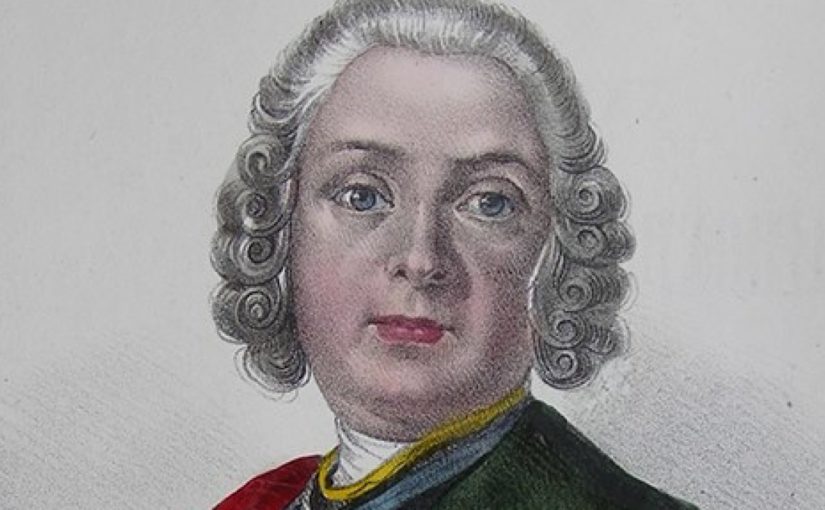In the year 1748 the powerful King of Prussia Frederick II sent a letter of commendation[1] to a little known Italian nobleman who had written an essay called “Best practices of military operations for the foot soldiers”. The author was Raimondo di Sangro, Prince of San Severo born on 30th January 1710 in Torre Maggiore near the major town of Foggia, in the southern Italian Region of Apulia.
What Frederick did, however, was both astonishing and baffling. Did he not realise that by writing such letter he was on the one side disquietly exposing the incompetence of his generals and on the other praising the excellence of mind of a mere minor foreign aristocrat ?
Raimondo was admired in life not only for his knowledge of the military arts and for inventing a new type of archibugio[2] ; he was also an accomplished alchemist, a genius of technology, a philanthropist and amongst many other things also a high ranking Freemason. In our times the Prince’s family name is known in Naples for its association with the Chapel of Sansevero, a shrine that had been built by the Prince’s ancestors in 1590 and magnificently refurbished by him between 1749 and 1771.
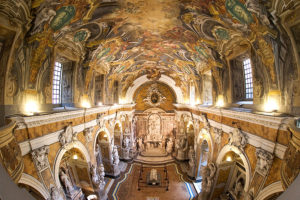
This wide angle picture shows that the inside of the Chapel in question contains several monuments, many of them beautiful and some also famous all over the world, like the “Veiled Christ” by the sculptor Giuseppe Sammartino. According to legend, that masterpiece was created in 1753 by the artist working in a hypnotic state induced by the Prince who, after completion, blinded the Sammartino to prevent him from replicating the secret technique applied to achieve such a stunning result. That exceptional sculpture represents Jesus Christ in death covered by a transparent looking marble shroud.
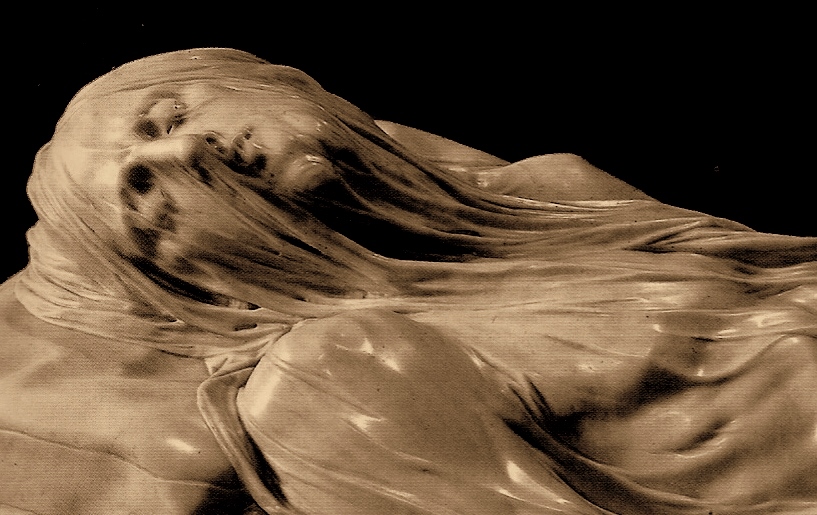
Some experts assert that the shroud and the subject were carved from one block of stone whilst legend states that Sammartino supplied the Prince with a suitable piece of cloth and the nobleman and alchemist , through a secret chemical process, transmuted it into that marble-like creation that covers the face and torso of the Christ. Displayed in the Chapel is the “Disinganno” – or “Disillusionment” – which is another excellent artwork that Raimondo commissioned to Francesco Queirolo[3].
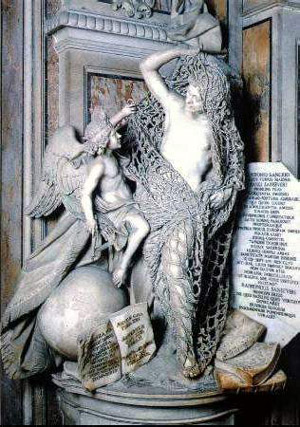
He dedicated it to his father Antonio di Sangro whom, after years of turmoil following the early death of his wife, returned to Naples in old age and committed the rest of his days to religious life. The human figure is shown in the act of disentangling itself from a net representing the many human sins, whilst the globe symbolises the earthly passions and the little winged Genie embodies the human intellect whose help is offered to assists man in his quest. At the base of the monument there can also be seen an open Bible and a square with compass which, together with the terrestrial globe, are all allegories used in freemasonry.
The other pieces of art put on show in the Chapel are some beautiful sculptured tributes to human virtues like modesty, decorum, truthfulness and sobriety, to mention but a few. To enlarge on what was the inspiration behind them would however be outside the scope of this paper.
Raimondo was the son of Antonio di Sangro, a noble Neapolitan and VII Prince of Sansevero and Cecilia Gaetani dell’Aquila di Aragona Sanseverino who also descended from an old patrician family. Her ancestor Benedetto Gaetani [4] , to mention one, had become Pope Bonifacio VIII in 1294. In fact Raimondo’s whole family genealogy is excellent; it stems from the Duke of Burgundy and has a connection with none other than the great Charlemagne! Such an illustrious ancestry guaranteed the Prince a rightful presence at the Court of the King of Naples with whom he had become a close friend in youth.
At the age of ten Raimondo had been sent to Rome by his father to study mathematics, pyrotechnic, hydrostatics, philosophy, canon and civil laws, at the Jesuit convent “Clementino”. It was in that city that with the official consent of Pope Benedict XIV, Raimondo dedicated his time to the reading of the “forbidden books” kept in the Vatican vaults whence he derived that knowledge that he later applied in his secret experiments.
In 1730 the Prince returned to Naples and made that city his permanent home.
In 1734 Charles Bourbon, Duke of Parma[5] , took Naples and the following year at the age of 18 was crowned its King as Charles VII. His installation on the throne marked the beginning of a long period of revival for the capital of southern Italy and flagged the start of the Prince of San Severo’s scientific activity to which the King was personally interested and had approved of. It is said that Raimondo had gifted Charles with another of his inventions: a rainproof hat.
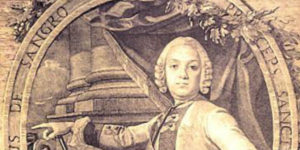
As the Colonel of his Regiment “Capitanata”, Raimondo di Sangro fought valiantly in 1744 at the battle of Velletri and with the defeat inflicted on the Habsburgs troops he played a big part in saving the Kingdom for Charles VII and the Bourbons. It was during that time of war that Raimondo had written the essay that brought him the recognition from Frederick of Prussia.
The Prince was a modest man who had no vices, did not like excesses and was also of a liberal mind. An affable person, he was nonetheless at times unable to keep his impulsive temperament under control. He spoke several languages, including Arabic and Hebrew and printed books from the basement of his Palace in Naples which he had equipped with his own presses. Amongst those publications was “The Travel of Cyrus” by the famous Freemason Michael Ranmsay [6] which the Prince had translated into Italian. After the war against the Austrians, Raimondo returned to spend his days in his secret laboratory that he kept in the vaults of the Chapel, where he made discoveries which could have made him one of the most famous scientists of his time.
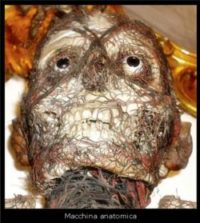 In the crypt of the Sansevero Chapel in Naples are kept the bodies of a man and a woman which the Prince called “anatomical machines”. They are actually skeletons wrapped by the ensemble of veins that are present in a human body. Chronicles report that the person, who injected the mysterious substance which forever preserved the vascular system of those corpses in a metallic-like state, might have been the anatomist Giuseppe Salerno from Palermo. But according to legend it was the Prince himself who experimented on his servants whilst they were still alive; hence the appellation of “sorcerer Prince” and “Devil’s apprentice” that stuck on him.
In the crypt of the Sansevero Chapel in Naples are kept the bodies of a man and a woman which the Prince called “anatomical machines”. They are actually skeletons wrapped by the ensemble of veins that are present in a human body. Chronicles report that the person, who injected the mysterious substance which forever preserved the vascular system of those corpses in a metallic-like state, might have been the anatomist Giuseppe Salerno from Palermo. But according to legend it was the Prince himself who experimented on his servants whilst they were still alive; hence the appellation of “sorcerer Prince” and “Devil’s apprentice” that stuck on him.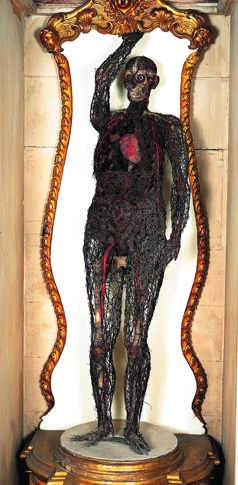
Although the Prince’s interests were mainly of a scientific and esoteric nature, he also had a good sense of humour and did not shy away from playing a few pranks , one of which is the following. The “Naples Gazette” dated 24 July 1770, reported that Raimondo di Sangro had built a splendid “Carrozza Marittima”, an amphibious carriage pulled by horses and capable of carrying up to twelve people and that such a marvel was seen defying the sea waves in Capo di Posillipo one sunny morning in July 1750. In truth, as the Prince revealed, that splendid machine was nothing more than a raft on which had been attached a painted wooden façade cut out in the shape of a carriage. The horses that appeared to be pulling the carriage were made of cork and the wheels were spun by men hidden behind the disguise. It was a practical joke that not everyone accepted in the right spirit. A year later, dueto the prolonged and regular contact with the intoxicating chemicals that he used in his experiments, the Prince passed away. This practical joke of the amphibious carriage might have been his amusing way of saying adieu to the world and to the people of Naples.
Chronicles report that amongst the many skills that Raimondo possessed, was also the ability of healing the sick with the use of remedies of his own preparation. He successfully applied that dexterity on Luigi Sanseverino, Prince of Bisignano, by saving him from near death after the most talented doctors of Naples had given up any hope. Even Tanucci, the Chief Minister at the Court of Charles VII, notwithstanding his dislike for Raimondo – mostly for being a freemason and therefore an enlightened mind – summoned him when he fell ill.
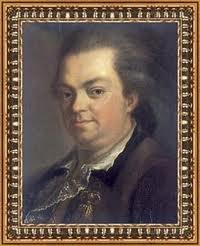
Twenty or so years later, that famous celebrated charlatan, swindler and Freemason who called himself Count Cagliostro – aka Giuseppe Balsamo from Palermo, Sicily – would have become famous all over Europe for doing exactly as the Prince of San Severo: cure the sick with his own secret magic potions. Except that Cagliostro committed the error of applying his prowess of traumaturgo on the rich as well as the poor people, thus attracting on himself the scorn of the aristocracy who later embroiled him in various plots, the most famous of all being the affair of the missing necklace at the Court of King Louis XVI of France in 1781.
When the Prince became the Grand Master of the Order of the Freemasons for the Kingdom of Naples in 1750 he risked being excommunicated by Pope Benedict XIV. In his defence he asserted that he had only gone into Freemasonry for he believed he was joining an operative order dedicated to the research and practice of Alchemy which was a subject that greatly interested him. The reality was of course quite different because many Masonic lodges of the time also included in their list of members, some progressive, enlightened and revolutionary minds[7]. Instead of making a full mea culpa, Raimondo even dared reprehend the Church in a letter by accusing it of approving idolatry – that pagan tradition of image worshipping – amongst the underprivileged population of the Kingdom and most particularly of the people of Naples.
Perhaps the legacy and influence of the di Sangros inside the Vatican and their noble lineage were stronger than one imagined for on that occasion the Prince, notwithstanding his blunders, was spared imprisonment and damnation.
Nonetheless, accusations of witchcraft and black magic continued to press against him ; the more so after he had claimed to have discovered a flame that could remain alive for an extensive period of time, even months, ”with the minimal lessening of the substance that fed it”.
The Prince wrote to the Florentine scientist Giovanni Giraldi that he had made the discovery by chance during one of his experiments , when a certain substance extracted from “… the bone of the most noble creature on earth; the best one being that from the head…” had caught fire. As the noblest creature on earth was interpreted to be man, we realise why there was never any truce in the war that his enemies engaged again the Prince! The only records that the Prince left us of that imperishable light are some sketches preserved in the Biblioteca Nazionale. The issue has left perplexed scholars in every age .
The Prince’s laboratory was locked up just before his death and never re-open ; the Chapel and his Palace have since remained in the hands of the Sansevero family which has never allowed for any investigations to take place there. According to another legend, when the Raimondo di Sangro felt that his days were coming to an end he gave instructions that after death his body should be cut in seven pieces by his servant and laid into a coffin whence he would resurrect nine months later. However his family , either fearful that the exercise could have come good and thereafter labelled all the Sanseveros as followers of the Devil or simply anxious to check on the progress of things , put an early end to the experiment by opening the tomb before time.
The Prince’s death has remained very much a mystery even to these days. His mortal remains and his actual place of rest – other than the official tomb seen in the Chapel – have not yet been discovered.
The author forbids any reproduction or publication of this article, in full or in part, without his explicit authorisation.
[1] Legler, Rolf (1990). Der Golf von Neapel (in German). Cologne: DuMont Buchverlag. p. 135
[2] Italian word for the predecessor of the musket though it was easier and lighter than that to carry
[3] He was an Italian sculptor born in Genoa in 1704. He was active in Rome and Naples
[4] Born in Anagni in 1235 and died in Rome in 1303
[5] He was the fifth son of Philip V King of Spain but eldest by his second wife Elisabetta Farnese
[6] G.D. Henderson: “Chevalier Ramsay” Thomas Nelson and Sons London, 1952. Michael Ramsay
(9 July 1686 – 6 May 1743) was born in Scotland but spent most of his life in France
[7] To read more about Freemasonry in the Kingdom of Naples in the XVIII century, read my paper entitled “Freemasonry under the shadow of the Vesuvius” of future release.
- MUSIC AND THE CRAFT – LUIGI BORGHI , A FREEMASON OF THE NINE MUSES LODGE - October 31, 2022
- SPILSBURY – THE FREEMASON FATHER OF FORENSIC SCIENCE - April 18, 2022
- THE MASONIC GLOVES - March 21, 2022

